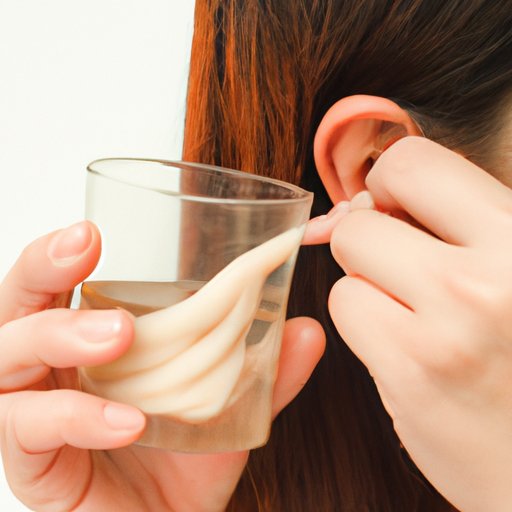
I. Introduction
Ear wax, also known as cerumen, is a natural substance produced by the ear to protect the ear canal from dirt and bacteria. While it’s normal to have some ear wax, excessive buildup can cause discomfort, hearing loss, and even infection. That’s why it’s important to remove ear wax safely and effectively to maintain healthy ear hygiene.

II. Best Practices for Using Ear Drops to Remove Ear Wax
Ear drops are a common and effective way to remove ear wax. Some recommended ear drops for this purpose include hydrogen peroxide, mineral oil, and glycerin. Before use, it’s important to follow correct dosage and frequency guidelines and read instructions carefully.
To safely administer ear drops, lie on your side with the affected ear facing up, and apply the drops as directed. Gently massage the ear to allow the drops to coat the inside of the ear canal. After a few minutes, tilt your head to the side to let the drops run out.
III. Home Remedies for Ear Wax Removal
In addition to ear drops, there are several natural home remedies for softening and removing ear wax. These include:
- Warm water
- Vinegar and rubbing alcohol solution
- Olive oil
- Baking soda and water solution
- Hydrogen peroxide and warm water solution
When using home remedies, it’s important to use caution and follow instructions carefully. It’s also important to choose the right remedy for your needs. For example, hydrogen peroxide may be too strong for some individuals, while olive oil may be better for those with extremely hard ear wax.
IV. Tools for Removing Ear Wax at Home
There are several tools available for safely removing ear wax at home. These include:
- Ear syringe or bulb syringe
- Ear picks or spoons
- Ear wax removal kits
- Cotton swabs (for outer ear only)
While each tool has its pros and cons, it’s important to be cautious when using them. Ear picks or spoons should never be inserted too deeply into the ear canal, and syringes should never be used with too much force. Cotton swabs should only be used for the outer ear and never inserted into the ear canal.
V. Benefits of Removing Ear Wax
Removing ear wax has several benefits, including improved hearing, reduced risk of ear infections, and improved overall ear health. Excessive ear wax buildup can cause hearing loss and interfere with ear canal health. By keeping ear wax levels in check, individuals can maintain proper ear hygiene and reduce their risk of uncomfortable symptoms.
VI. The Dangers of Improper Ear Wax Removal
Improper ear wax removal can cause serious damage to the ear, including risk of ear drum damage, temporary hearing loss, and even infection. It’s important to avoid removing ear wax with sharp objects like cotton swabs or toothpicks, which can push ear wax deeper into the ear canal or damage sensitive ear components.
If you experience pain, discharge, or hearing loss during ear wax removal, stop immediately and seek professional help. Individuals with a history of ear problems, like frequent infections or a perforated ear drum, should consult a healthcare provider before using any ear wax removal methods.
VII. Q&A: Common Questions About Ear Wax Removal
Here are answers to some of the most common questions about ear wax removal:
How frequently does ear wax need to be removed? It varies between individuals, but most people only need to remove ear wax every few months.
How to tell if you have too much ear wax? Symptoms of excessive ear wax include ear pain, difficulty hearing, ringing in the ears, and a feeling of fullness in the ear.
Is it safe to remove ear wax at home? Yes, but only if done safely and following good hygiene practices. If you experience pain or hearing loss, stop immediately and seek professional help.
VIII. Ear Hygiene: Tips for Maintaining Clean Ears
Maintaining clean ears can help prevent excessive ear wax buildup and reduce your risk of infection. Some tips for maintaining proper ear hygiene include:
- Regularly cleaning the outer ear (with a damp cloth) and surrounding areas
- Avoiding inserting sharp objects into the ear canal
- Avoiding exposure to loud noises for extended periods of time
- Wearing earplugs during swimming or water activities
- Seeing a healthcare provider regularly to check ear health
IX. Conclusion
Ear wax removal is an important aspect of ear hygiene. By using safe and effective methods like ear drops and home remedies, individuals can reduce their risk of infections, improve hearing, and maintain healthy ears. Remember to be cautious when using tools like syringes or picks, and always seek professional help if necessary.
By following good ear hygiene practices, individuals can prevent excessive ear wax buildup and maintain overall ear health.





